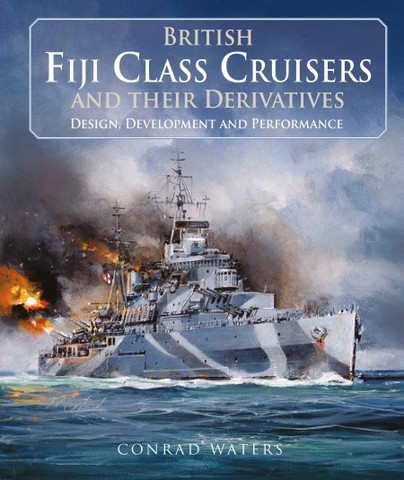
British Fiji Class Cruisers and Their Derivatives. Development and Performance. By Conrad Waters. Seaforth Publishing, an imprint of Pen & Sword Books, Barnsley, 2024. ISBN 978-1-5267-9983-8
Reviewed by David Hobbs
This book follows Conrad Waters’ book on Town class cruisers published in 2019 but he will probably be better known to ANI members as the editor of Seaforth’s annual World Naval Review.
His historical interest has focused mainly on the design and development of British cruisers from the 1930s onwards and this book is a testament to the depth of his research and analysis.
It is a heavy book in Seaforth’s large-scale format comprising over 400 pages with 264 excellent black and white photographs. There are also 14 colour photographs, 14 coloured drawings showing the camouflage schemes used by different ships during World War 2 and 56 drawings. The latter include a fold-out ‘as-fitted’ colour profile and aerial rigs copied from the National Maritime Collection at the Woolwich Brass Foundry and a number of drawings by John Jordan, AD Baker III and George Richardson drawn especially for this book to show the ships’ different profiles, internal arrangements and action damage. It would be difficult to imagine a more comprehensive description of this class and Waters has created a book that is likely to remain the definitive work on the subject.
None of the ships described served with the RAN but the loan of Gambia to the RNZN is well covered together with the donation of two ships to the RCN. The modified Fiji class ships described include Ceylon, Newfoundland, Swiftsure and Superb and the coverage of Fiji derivatives ends with the Royal Navy’s last cruisers, the Tiger class. Several of the ships described served with the BPF and in the post war Far East Fleet; these will be familiar to Australians who operated with them. Another ship, Nigeria was sold to India and served with the Indian Navy as Mysore until the mid-1980s.
The first two chapters cover the design and development of the class including details that will interest those who study the impact of political restrictions on warship design. The Fijis were a product of the second London Naval Treaty of 1936 which imposed an individual limit of 8,000 tons on light cruisers, considerably less than the previous Town class. This led to ships with adequate armament but cramped accommodation and limited space for the many improvements in radar, command systems and close-range anti-aircraft armament that the Admiralty sought to make during the Second World War. Something had to be removed to provide sufficient space and a weight allowance for every proposed modification. Stability and structural strength were constant concerns and the last ships had to have their beam increased by one foot to improve matters. The early ships were built with four triple 6-inch gun turrets but one of these, ‘X’ turret, had to be landed to keep stability within tolerable limits and make space available for new equipment. Despite their inherent weaknesses, the Fijis performed well in action with only two ships lost in wartime operations. One of these, Trinidad, was hit by one of its own torpedoes which went ‘rogue’ after launch. In the immediate years after the Second World War several ships of this group proved to be ideal flagships on the smaller RN stations around the world but by 1960 their obsolescent anti-aircraft armament and unaffordably large manpower requirements led to their withdrawal from service.
Conrad Waters clearly put a great deal of study and research into the creation of this remarkable book. It would be churlish to criticise any aspect of it but I do have an observation. Many of the photographs have extended captions; this is a good thing in general but some repeat what is said in the main text on the same page. If you read the book from cover to cover, as I did, this can be irksome but, on the other hand, those who use the book as a reference source may find the captions advantageous since the information sought may be found simply by referring to an appropriate photograph. Overall, the captions add to the wealth of material on offer.
This book gives readers an insight into the wealth of relevant material held in Admiralty files at the UK National Archive at Kew and the drawings held by the UK National Maritime Museum at its Brass Foundry archive in Woolwich which might not otherwise be easy to access. Anyone with an interest in the development of warships in general and British cruisers from the late 1930s onwards will, therefore, find this to be an excellent reference source. Notwithstanding its high recommended price tag, I would highly recommend it.



